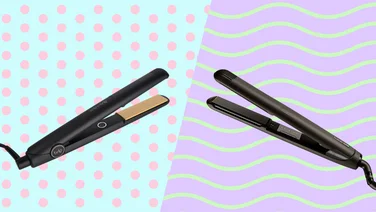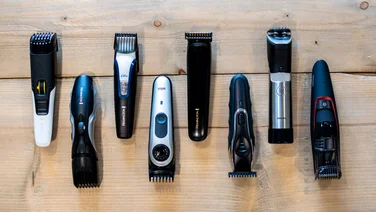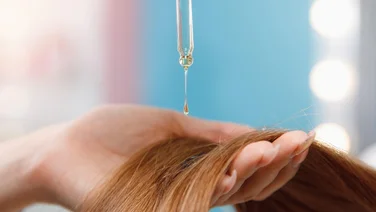To help us provide you with free impartial advice, we may earn a commission if you buy through links on our site. Learn more
- What is frizzy hair?
- Why does hair get frizzy?
- How to stop frizzy hair
- Use the right products
- Get your wash routine right
- Seal your hair after washing
- Be gentle when you brush
- Cut down on heat styling
- Protect your hair when you sleep
- Head to your hairdresser
- Avoid touching your hair too much
- Be gentle when you dry your hair

If your hair feels dry, flyaway and difficult to style, or you begin the day with sleek hair that becomes fluffier as the day goes on, you might be suffering from frizzy hair. If you want to understand the science behind frizz, the reasons it happens and how to best manage it, then below we reveal everything you need to know about frizzy hair and how to stop it.
What is frizzy hair?
Frizzy hair isn’t smooth and sees strands standing away from the scalp. It’s usually dry, flyaway and prone to tangling. Frizzy hair usually feels coarse to the touch, too. It can also be puffy and tends to react strongly to humidity, becoming fluffier and expanding in volume when it’s exposed to moisture.

Frizzy hair often lacks moisture, so it can feel dry and brittle, as well as looking dull. This can mean styling and achieving shine can be a challenge. In fact, maintaining a style can prove difficult, especially if there’s moisture in the air.
READ NEXT: The best products for frizzy hair
Why does hair get frizzy?
Frizz is predominantly the result of a lack of moisture, as well as the structure of the hair strands themselves. When hair is dry, it looks for moisture from the air. This causes the hair shaft to swell, resulting in frizz – especially in humid conditions. Dry environments can also strip moisture from the hair, leading to frizz.Hair porosity plays a part, too. High porosity hair tends to absorb moisture quickly, but loses it just as fast, leading to frizz as strands struggle to retain moisture. Damaged hair also becomes more porous, which lets moisture enter and escape the hair shaft more freely, resulting in frizz.
Certain hair textures, such as curly, coily or wavy hair, are more prone to frizz due to their structure. The bends and twists in the hair shaft make it more difficult for natural oils to travel down to the ends of the hair. This leads to drier hair, which as mentioned, means more frizz.
READ NEXT: The best products for curly hair
How to stop frizzy hair
To achieve smooth, frizz-free locks, you need to follow the right routine, using suitable products. So, if you’re looking for ways to reduce and control your frizzy hair, here are the changes to make to see the difference.
Use the right products
Look for products specifically designed to hydrate and smooth frizzy hair. Getting the right shampoo, conditioner and hair treatments – such as deep conditioners, for example, can make a huge difference to the look and feel of your hair. Avoid ingredients that may dry out your hair, such as alcohol and sulphates. Instead choose hydrating, moisturising ingredients such as argan oil, coconut oil, shea butter, glycerin, avocado oil, hyaluronic acid, aloe vera and jojoba oil. These can help to restore moisture, smooth the hair cuticle and reduce frizz. Leave-in conditioners and serums help to lock in moisture after washing, too.
READ NEXT: The best shampoo and conditioners to buy
Get your wash routine right
Washing your hair too often can strip it of its natural oils, which leads to dryness and frizz. Try to space out your hair washes to maintain these natural oils, which help to protect and moisturise your hair. Figuring out the frequency of washes might involve some trial and error, but it will be time well spent to stop or reduce that frizz.
Seal your hair after washing
Once you’ve conditioned hair, rinse it with cold water. Cold water helps to seal the hair cuticle, reducing frizz and creating a smoother appearance. Leave-in formulas and anti-frizz products can help you control frizz without hair feeling weighed down.
READ NEXT: The best conditioners for dry hair
Be gentle when you brush
When your hair is wet, use a wide-tooth detangling comb or a brush to minimise breakage and reduce frizz. If you’re worried about tangles, comb through hair once you’ve applied your leave-in conditioner or serum.
READ NEXT: The best hairbrushes to buy
Cut down on heat styling
Try to reduce how often you style your hair with heat. If you do need to use heat on your hair, turn down the temperature and apply a heat protectant spray beforehand to reduce the risk of heat damage to your hair, which can dry out hair, leading to more frizz and breakage.
Protect your hair when you sleep
Your hair will often move around and become tangled when you sleep, which again leads to dryness and frizz. A silk or satin pillowcase can help to reduce the friction as you move around at night. An alternative is to wrap your hair in a silk scarf or bonnet overnight to keep your hair protected.
READ NEXT: The best hair mask to buy
Head to your hairdresser
Regular trims can help to get rid of split ends and maintain the health of your hair. This can remove damaged hair and reduce the likelihood of frizz. You can also take the opportunity to ask your hairdresser for advice on treatments or services that can help manage your frizzy hair. They can offer professional advice on the best way to work with frizzy hair.
READ NEXT: The best hairdressing scissors to buy
Avoid touching your hair too much
Touching or brushing your hair too often can lead to frizz; it disrupts the cuticle of your hair. Protective hairstyles such as braids or buns keep your hair secure and reduce exposure to environmental factors, and stop you from touching your hair too often.
Be gentle when you dry your hair
How you dry your hair can have a significant impact on the level of frizziness. The friction of vigorously rubbing your hair with a towel can roughen up the hair cuticle and lead to frizz. Instead, patting or gently squeezing with a towel removes excess water without causing damage. Air drying and using a diffuser can help to reduce frizz, too, especially if you use the lowest heat setting and dry your hair in sections from the roots to ends.






